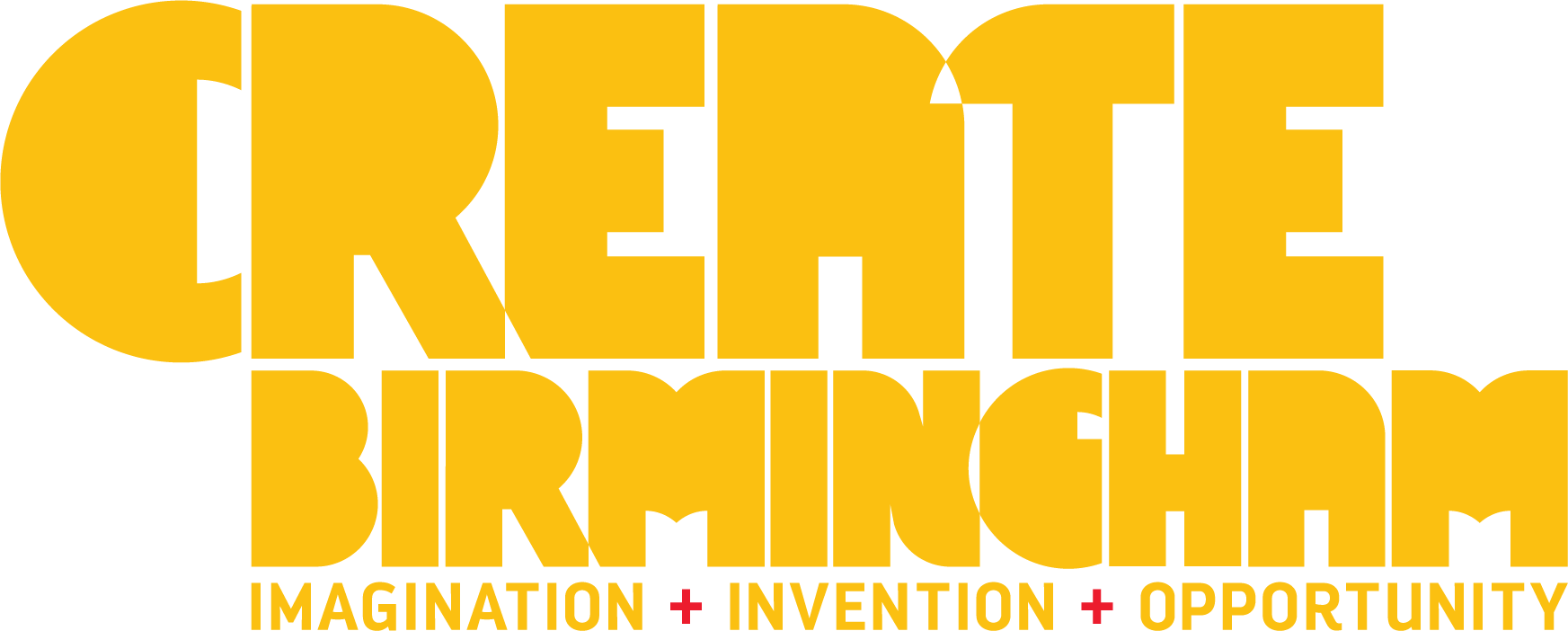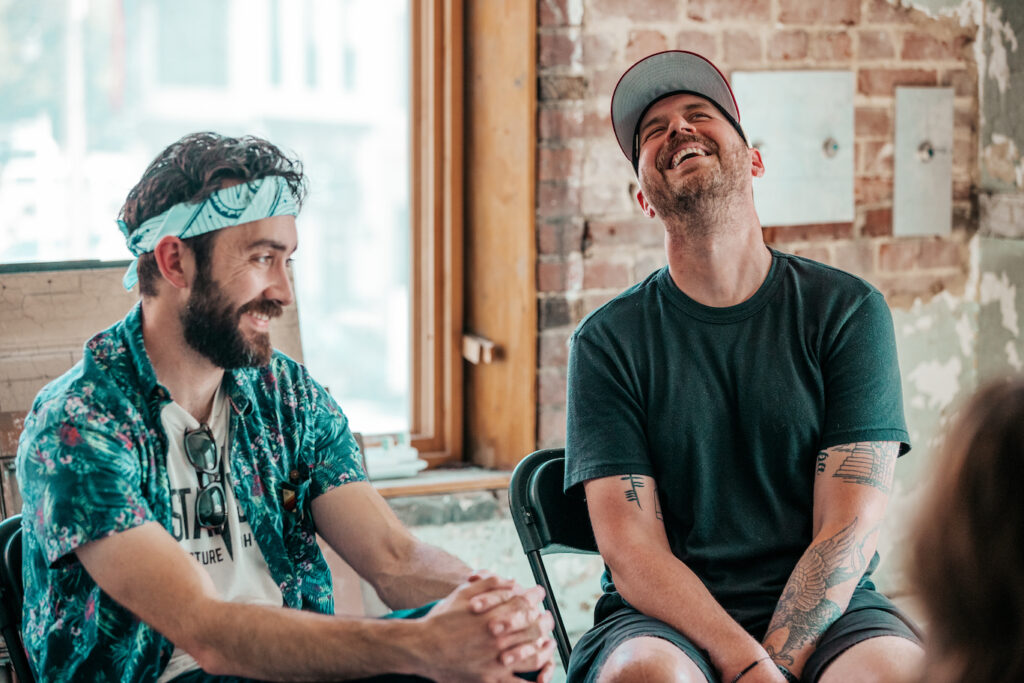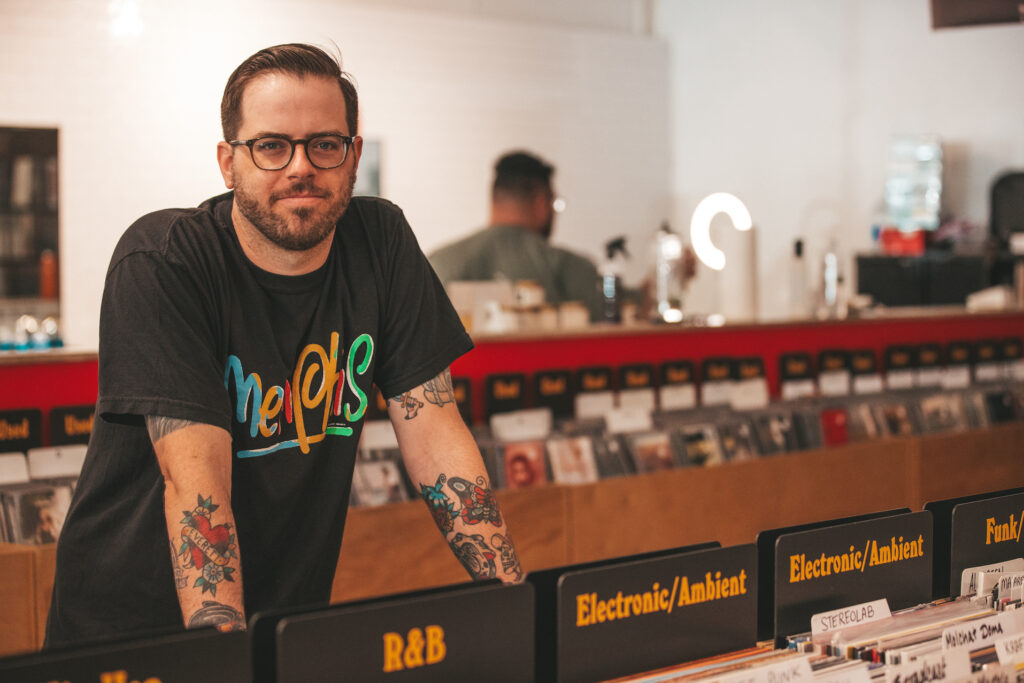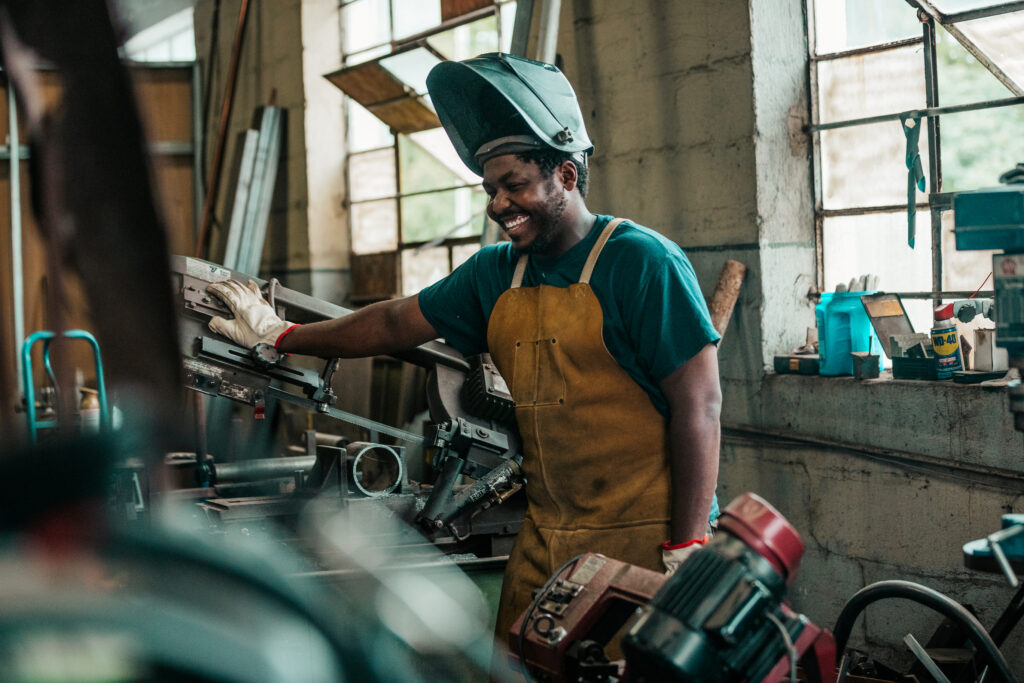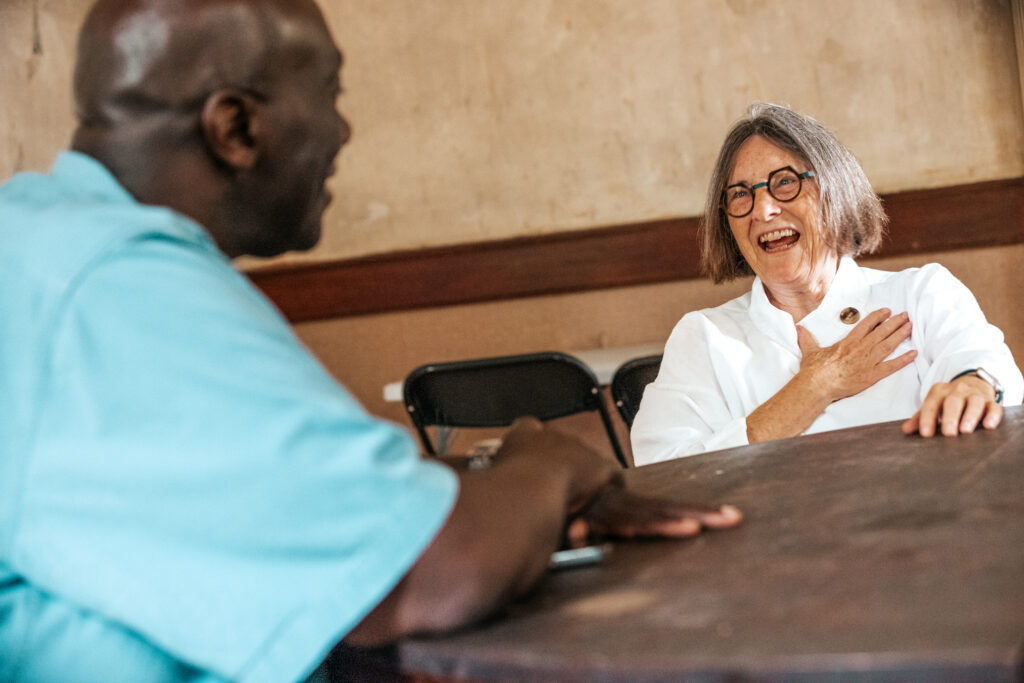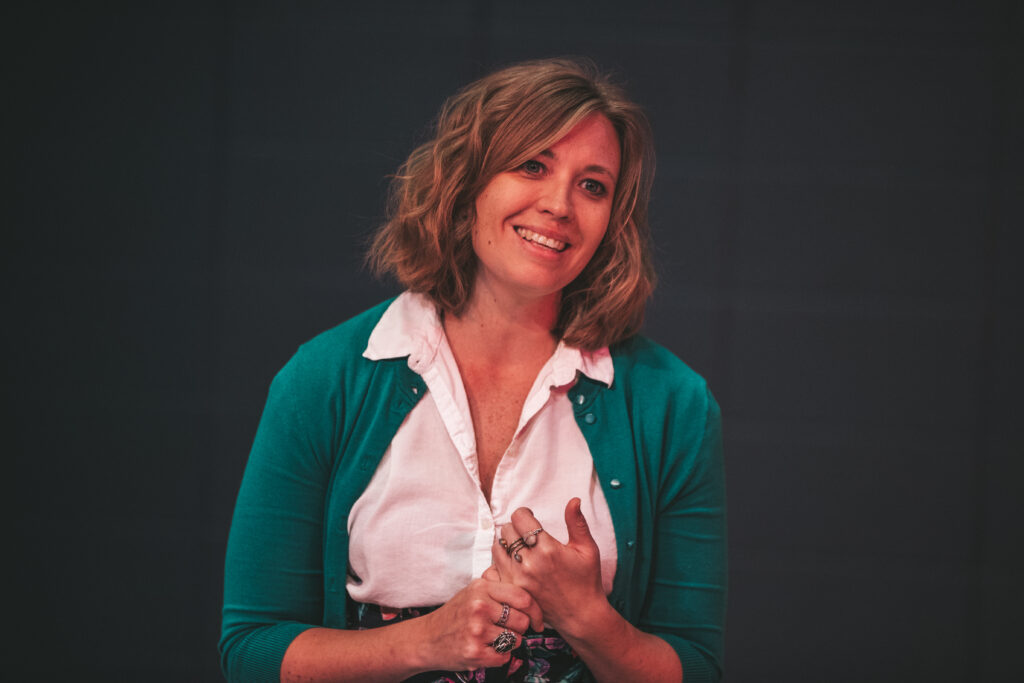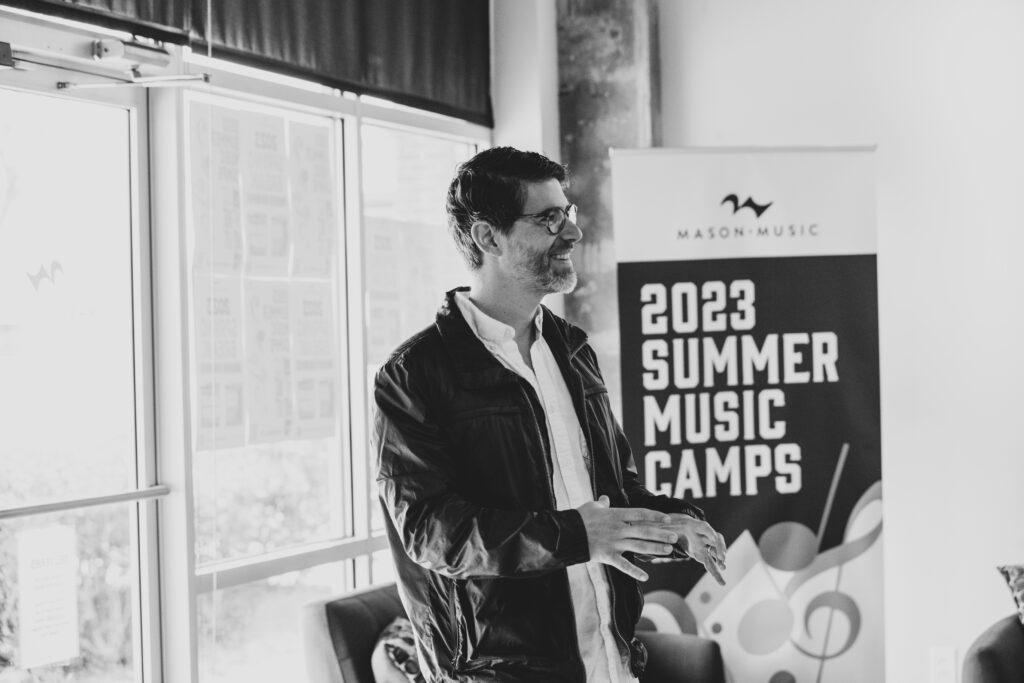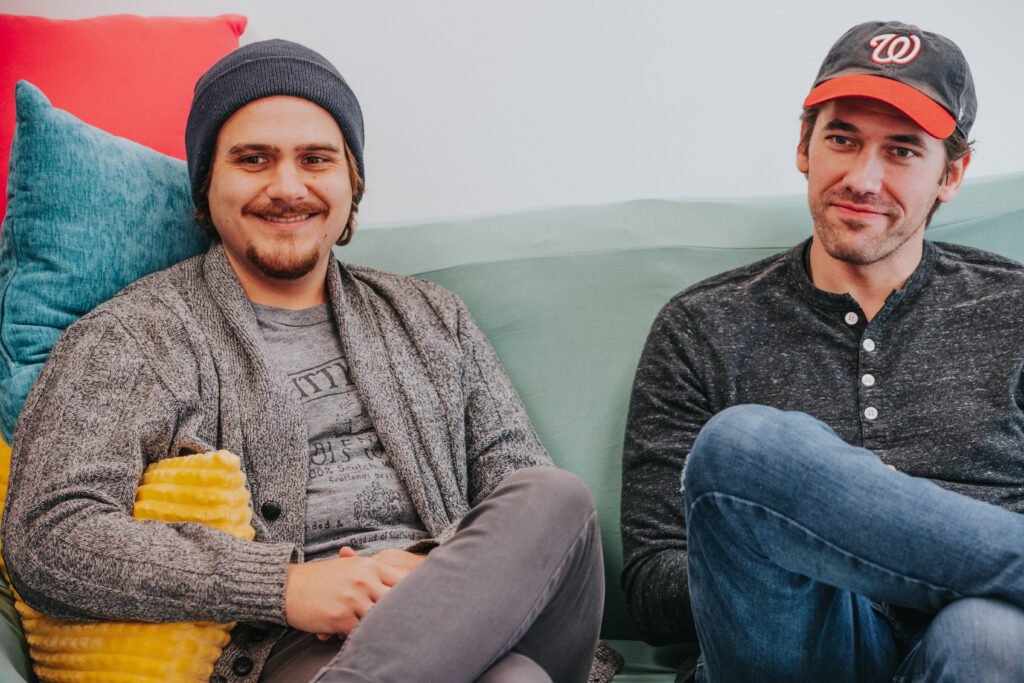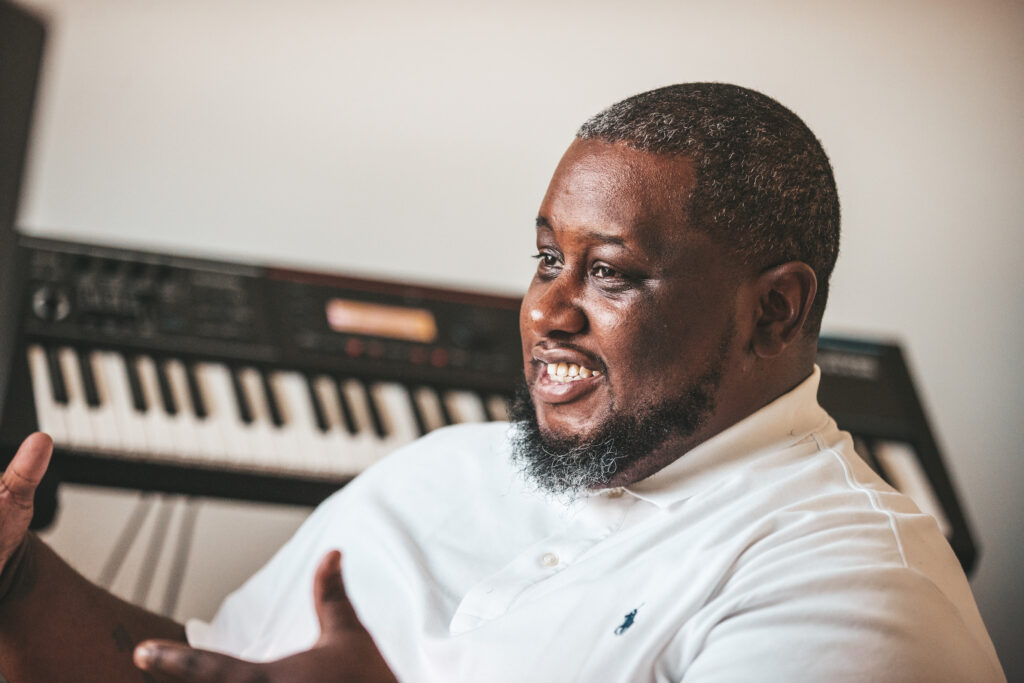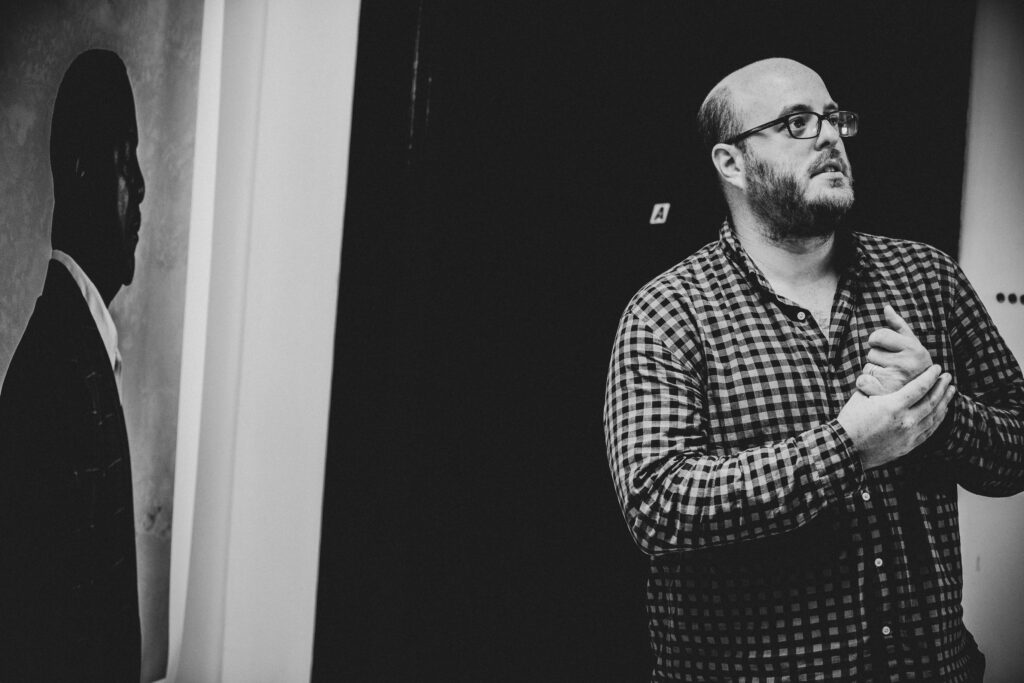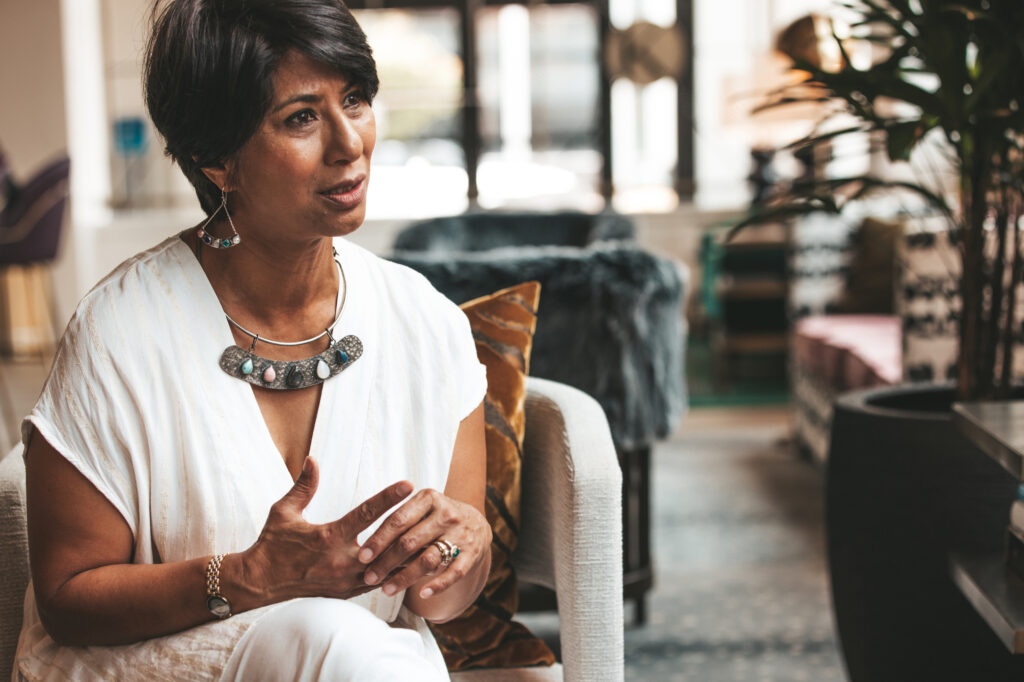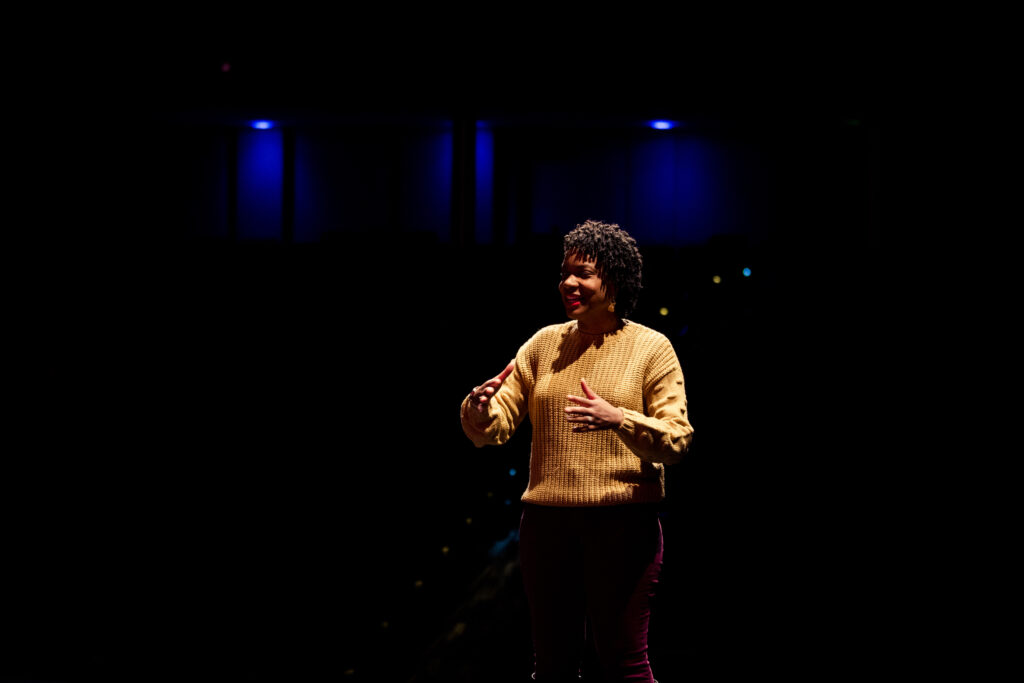Interview: Imani Richardson
Photos: DeSean Motley
Ebone’ Gilbert, Atuarra “Arty” McCaslin, Erika Mixon, and Jamelia Pearson are the co-founders of Fairfield Black Art Collective, an arts initiative composed of talented and dedicated Black artists from Fairfield, Alabama. Their mission is to provide a platform for Black artists to share their unique perspectives and experiences through their art while also creating spaces for us to celebrate our roots, honor those who paved the way for us, and embolden those coming behind. We had the pleasure of talking to FBAC about their dedication to not only shining a light on Black art and artists but also encouraging the youth of Fairfield and the Greater Birmingham area to nurture their gifts and talents.
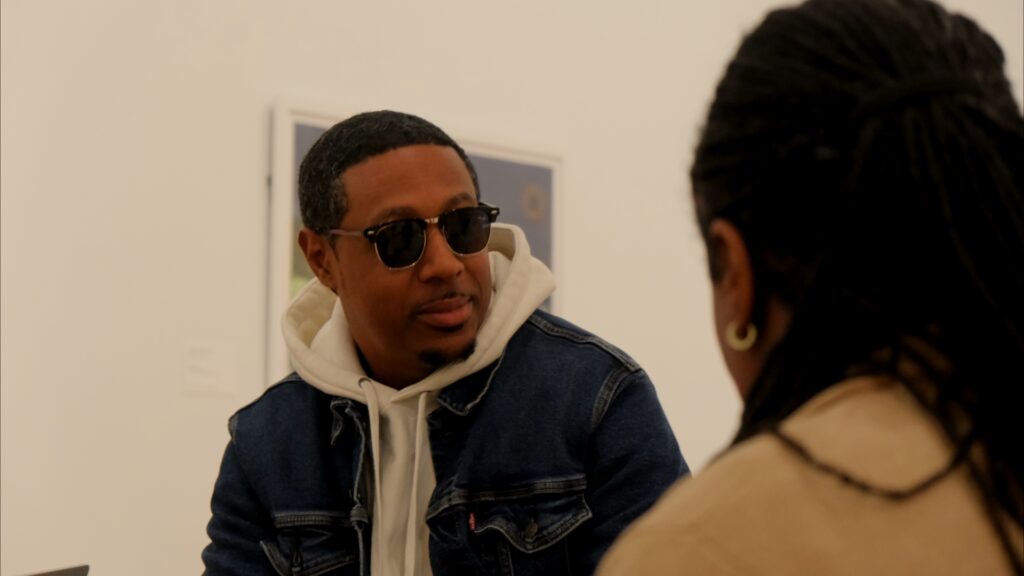 Tell us a bit about Fairfield Black Art Collective. What’s your story, and how did you come to be?
Tell us a bit about Fairfield Black Art Collective. What’s your story, and how did you come to be?
Ebone’: Okay, I can give you the short, abridged version. I went to Art Basel in Miami for the first time in 2022. I was at an event, and I thought I saw Arty. It was very visceral because I was about to yell across the space, “ARTY!” (laughs) And then I was like, oh wait a minute, that’s not him! Glad we kept decorum and acted like we’ve been somewhere before, right?
So I was posting visuals on my story, and he inboxed me, asking how it was. And I told him, “I thought I saw you there.” Probably a week or so after, he came to me and said, “Hey Eb, I’m thinking about putting a small show together, something at home. Can you send me some potential venues that I can scout?” I told him sure.
We ended up having another conversation, and basically, I said, well, instead of doing a solo show, have you thought about doing a small group show?
Now pause. Arty, Erika, and I went to high school together. Arty’s class of ’99, Erika’s class of ’00, and I’m class of ’01. I’ve been knowing Jamelia since I was 12. I’d been seeing Erika in the art scene a lot more since the pandemic, so we had that connection. I discovered Jamelia was a closeted artist during the pandemic as well. Arty and I had worked together when we both lived in Atlanta in 2016, and Erika asked me if she could paint one of the photos that we took. Another photo that Jamelia saw of me, she also asked if she could paint.
So I said I have two ladies that I think should be put in the conversation if we’re talking about doing an art show. And here we are. That’s the short, abridged version. (laughs)
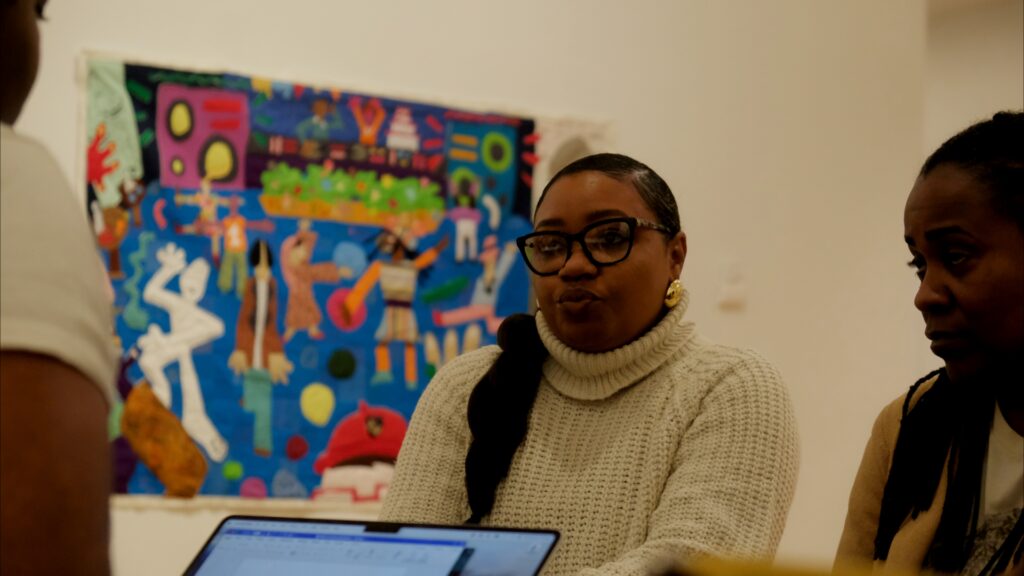 Here you are. So this led to y’all’s first small group show together?
Here you are. So this led to y’all’s first small group show together?
Ebone’: Yep.
Arty: Well, I wouldn’t say it was small—because it wasn’t just us.
Ebone’: Yes, we ended up having ten artists and two students for our group art show, Cultural Collateral, which we did last May. It expanded from the four of us coming together to produce a group show to us, and specifically Erika saying, “I’m going to throw this out there—how do y’all feel about starting an arts initiative in the form of a collective?”
And there it is. Fairfield Black Art Collective, because we are all from Fairfield. Now, Jamelia’s not a graduate of Fairfield High, but…
But y’all still claim her?
Jamelia: I claim them. (laughs)
Ebone’: She’s rooted. We went to church together. Our church, Thompson Chapel AME Zion, was across the street from Arty’s family’s house.
Erika: And your family is from Fairfield.
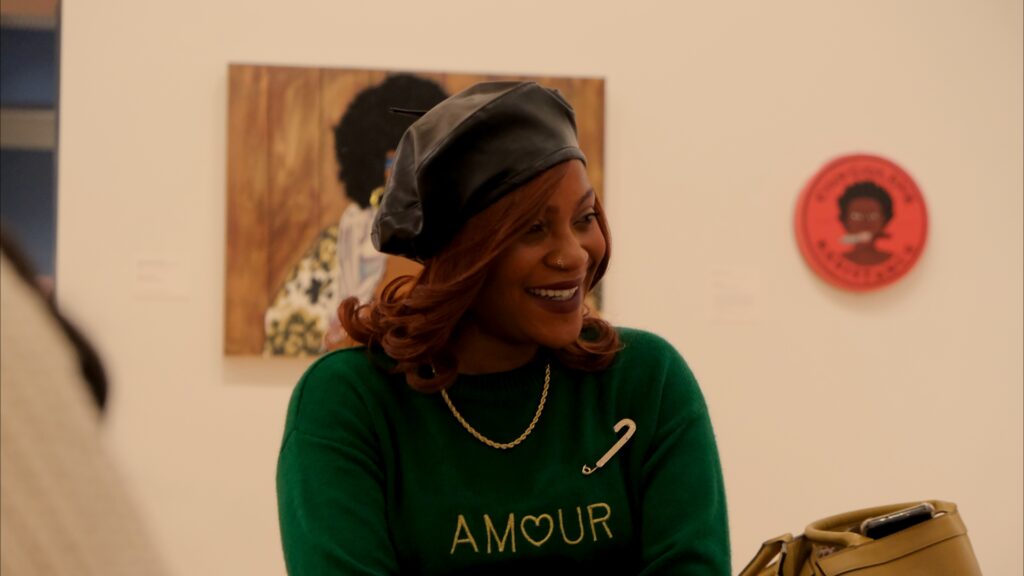 Jamelia: Yes, my family is deeply rooted in Fairfield. My mother is from Fairfield, my father is from Fairfield, my grandparents, both sets, lived out there, all of my aunts and uncles—Everybody lives in Fairfield or is from Fairfield.
Jamelia: Yes, my family is deeply rooted in Fairfield. My mother is from Fairfield, my father is from Fairfield, my grandparents, both sets, lived out there, all of my aunts and uncles—Everybody lives in Fairfield or is from Fairfield.
Arty: I think most of our families are. My dad was born and raised in Fairfield.
Jamelia: Our fathers know each other from childhood.
That’s an amazing starting point. So even though you’ve known each other a long time, most of your work as a collective has been recent, since the pandemic?
Erika: 2023 is when we started the conversation, in January.
Oh wow! So FBAC is fresh.
Arty: Yes we’re just about to come up on a year.
Ebone’: We’re just getting into toddler stage. (laughs)
Yes, it’s early, but it’s such a cool and unique experience to be able to start out in the way you did.
What was the idea behind Cultural Collateral when you were bringing it together? Were there any themes you wanted to explore?
Erika: With Cultural Collateral, we were talking about things like cultural identity and appropriation, and we landed on that because we wanted to talk about how Black artists, and really the Black community, are used as collateral. People profit off of us and a lot of the ideas we create in society. We’re the originators of so many things, but we’re not always afforded the opportunity to capitalize on our gifts and contributions.
So we went with that, and we kind of made it more broad as well so that we could incorporate a lot of different interpretations and responses to that theme, and show different skill sets. These people were anywhere from students to veteran artists, emerging artists, we really wanted to open the show and give everybody a chance. Black art created by Black artists, telling our stories from our perspective.
Yes, and I love the way that you opened it up to include artists who are at different stages of their journey and career. Having a space and opportunity to show your work is so valuable, especially as a young person. I think it’s beautiful that you all decided this should be open to not just to more seasoned artists, but also to students.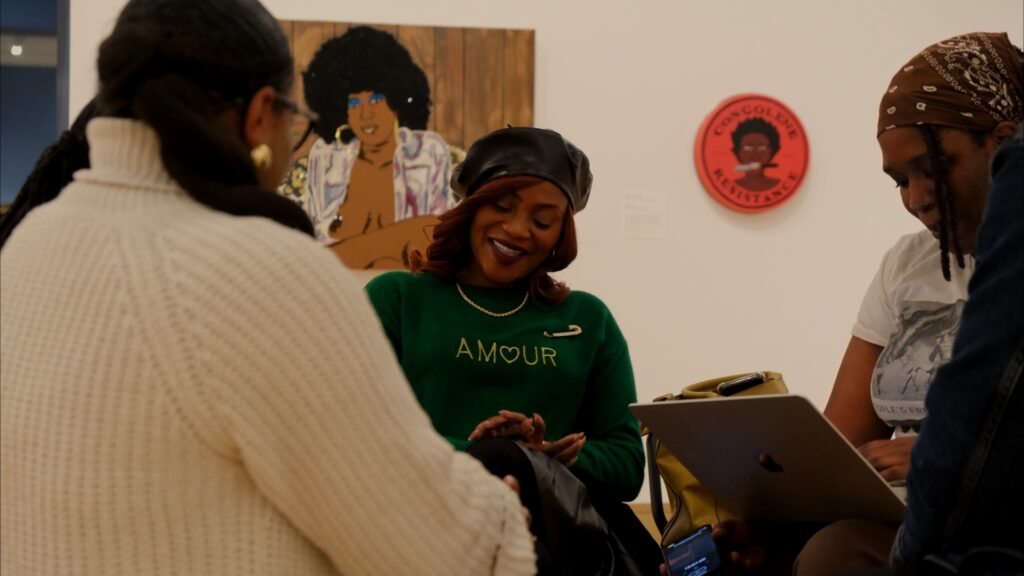
Erika: It can be intimidating for some. That’s why we also take care to the process by which we’re onboarding the artist, so they feel welcome. Understanding that this is a safe space where even if you’re next to a bigger artist, we’re here to help each and encourage other.
Who introduced you, or what was your introduction to art? And how did that foundation guide you through your life and into your current moment?
Arty: I was pretty much born into this whole creative life, I guess you could say, from an early age. My origin story would definitely have to start with my parents and my family. My parents started a theater production company in New York way back in the 80s, and they merged a lot of different cultures while they were out there. They took the culture of Ballroom, hair shows, the performing arts, and dance and merged them, and throughout the years, that changed into looking more like outreach in Black communities, more specifically in Fairfield, to fill in the hole that was a lack of support in the arts and a place for creative people.
My aunt was the one who refined my tastes in art. She introduced me to much more worldly art, things from the Renaissance period (both the European and the Harlem one) and really gave me a deep appreciation for it.
And even a little bit at Fairfield. I don’t know if y’all remember, but there was an art teacher—his name was Mr. Cool. They had a program where they partnered up with Lawson State Community College, and they would teach us about illustration and animation. So I really fell in love with that medium of artistic expression. But anything that creative was something I was drawn to.
I do think my aunt had a lot of influence. I used to go up to her house, and she taught me how to use charcoal. From when I was 8 or 9 years old, I was drawing and participating in art competitions. That’s how I fell in love with art. Ever since then, even when I stopped doing it, it kept bringing me back. So my family was very instrumental in me being exposed to not just only painting and illustrating, but all the creative arts, anything from dance, music, to everything else.
That’s beautiful. I love when a family or the adults around a child can recognize that they have a passion and a gift and facilitate them pursuing that. Really pouring into them.
Arty: Yeah. Ebone’ was a part of that too as a dancer.
Erika: So with my story, I didn’t have any formal exposure to art. I was an only child, so I definitely entertained myself. My parents were very excited that they didn’t need to entertain me. I would do shows at home. (laughs)
I always tried to recreate what I saw on TV. When I saw the American Music Awards, I then had an award show at home. Looney Tunes was my one of my favorites. I had a vivid imagination, but I think what gravitated me towards drawing was when I saw cartoons, I wanted to recreate them. I would like them and try to trace, or copy, anything to make the shape. I would do that every time I watched a cartoon.
 Later on, my mom and dad, just like how we were talking about parents being encouraging, didn’t just say, “Now what is she doing today?” No, it was, “Oh she likes this.” So I would ask if I could get paintbrushes, and they would buy them. That’s when I started painting and doodling.
Later on, my mom and dad, just like how we were talking about parents being encouraging, didn’t just say, “Now what is she doing today?” No, it was, “Oh she likes this.” So I would ask if I could get paintbrushes, and they would buy them. That’s when I started painting and doodling.
Then around the age of 13, my mom actually paid for classes for oil painting, and I didn’t know anything about that. It was a local painter, who’s actually going to be in the show y’all. He’s very, very good. I had maybe five classes, that’s it, but he introduced me to oil painting, and that’s what got me down this road as an artist. I just fell in love with that process, the colors, how to blend, and it just felt good.
That’s what got me into the art world as far as painting, but I love the arts in general, the performing arts, all of it. I’m just a fan of these types of outlets.
Jamelia: You know, just sitting here listening to everyone, I think it’s interesting that we all pretty much have the same story. I can remember being 7 or 8 years old and stopping Inspector Gadget. I’m putting my age out there, but I can remember pausing the TV downstairs and drawing on a chalkboard what I saw. Same thing if I saw a magazine and there was a cartoon, or just anything that interested me; I felt like, “Well, let me just try this.”
I have this thing where I don’t like for things to defeat me. So if there’s something I want to do, I’m going to give it my all to see if I can do it or not. And I could! So my mom and dad recognized that.
Going back, sending us to Fairfield for the summers to our grandparents’ house, my grandma would always have a spread laid out for me. She said, “You got all your markers, your paintbrushes, but take that outside. Do whatever you want to do, but not in here.” (laughs)
That turned into my cousins and my friends bringing me their jeans. I would draw cartoons on the jeans, and you know, we were the cool kids. Everybody was bringing their stuff over asking, “Can you draw it on my shoes too?” So that’s how I got started.
 I was big into sports too, so I put my art to the side for a little while until I got older. I too have an aunt that sold Black art. To go down to her house in Montgomery, Alabama was almost like going to a museum. You see all of these pictures on the wall, all of these people who look like me, who are really doing this. She made it a point to educate us on what it was we were looking at, what our heritage was, where our history comes from. That was something that always stuck with me as well.
I was big into sports too, so I put my art to the side for a little while until I got older. I too have an aunt that sold Black art. To go down to her house in Montgomery, Alabama was almost like going to a museum. You see all of these pictures on the wall, all of these people who look like me, who are really doing this. She made it a point to educate us on what it was we were looking at, what our heritage was, where our history comes from. That was something that always stuck with me as well.
So like Ebone’ said, she found me at the house one day just painting. I called her over after I asked her about a picture, and said, “Come look at this. Tell me what you think.” When she came in, and she liked what I was doing, I knew at that point, even this late in age and in life, that I had something. If a person that I am painting or drawing, can come in and see their resemblance, or they feel like they’re looking at themselves? Job well done, Jamelia, you’ve reached your goal on that.
I also have a cousin that has been encouraging me since forever to do something with my art. She’s been very influential and inspirational, as far as me wanting to step out on a limb and say I can do this.
So again, I just think that it’s amazing that all of our stories are connected. I think Erika may have been the only person who I really didn’t know, but like Ebone’ said, I’ve known her since she was a kid. I knew who Arty was because he was right across the street, and I was looking at him every Sunday. I was dropping my cousin off at his house every Sunday, just waving at him when they were going to practice.
Arty: I didn’t know who I was waving at.
Jamelia: Right, but it was me!
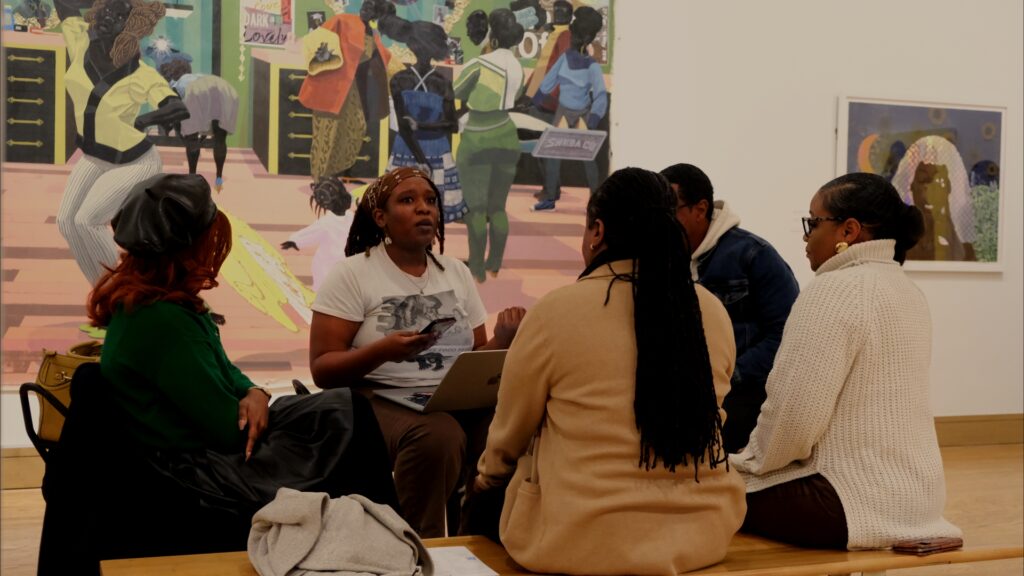 Ebone’: So I’m the only performance artist out of this group, and when I moved to Fairfield when I was 12, Arty’s mom and dad had Sparkle Theater Production Inc. at our local community center. That was my first introduction, period, and it was a full immersion of theater, computer literacy, spoken word, dance, modeling. That segued into me continuing in the performance arts, going to college for theater, being a writer and a dancer.
Ebone’: So I’m the only performance artist out of this group, and when I moved to Fairfield when I was 12, Arty’s mom and dad had Sparkle Theater Production Inc. at our local community center. That was my first introduction, period, and it was a full immersion of theater, computer literacy, spoken word, dance, modeling. That segued into me continuing in the performance arts, going to college for theater, being a writer and a dancer.
At 40, the structure and the advocacy is something I can definitely appreciate. It was very important for his parents and everyone who was a part of Sparkle. The intentionality, the culture, and the history was really poured into us because Frank McCaslin wanted us to know that it was always bigger than us and what we were in the moment. So times like when we traveled to New Orleans as children all the time, being able to see vastly different types of cultures, but also always driving home that we are amazing Black people first. Doesn’t matter the level. I mean, when we think of some of the choreography that we learned, I learned “Rhythm Nation” when I was 11, and can still do it at 40.
So that was my introduction, and I don’t come from a family of artists. I am proverbially the only one in a sense, but I never felt that I was the lone ranger or the odd man out. When he identified what your strengths and weaknesses were, he encouraged and he poured into that.
So yeah, Arty and I have danced together, Erika and I have danced and performed together. It was a staple for a long time.
Arty: I mean, they’re still doing this to this day. And when you get to a certain point artistically, you start recognizing the need. Even with Cultural Collateral, Ebone’ came up with the main idea for what the show should be.
Ebone’: I just felt like I was kind of over the appropriation of Black art. I felt like culturally we’re just collateral.
Arty: And that was it. Even around Fairfield, we started recognizing the need for the arts in Black communities, and how that’s really taking off nationally. I think one of our thoughts was, “Why isn’t this more of thing in Birmingham?” I mean, we’ve got Carver Theater, our Jazz Festivals. We’ve got such a rich history of art here in Birmingham. Folks from the Harlem Renaissance came down here to perform. It was really an epicenter.
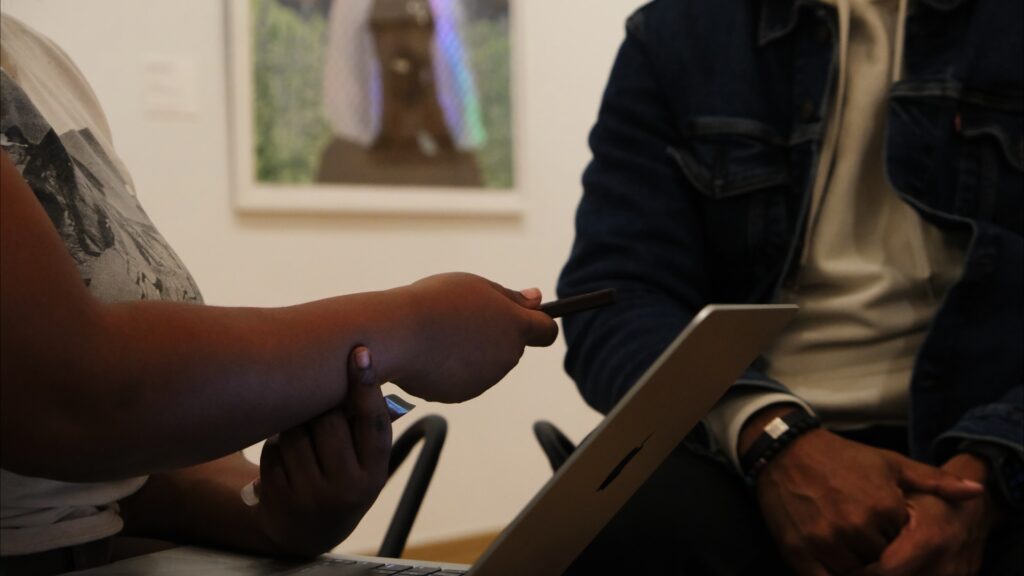 Erika: And to touch on what Arty was pointing out and add a part of our origin story that I didn’t tell that’s a component of the need we’re serving as the Collective. Outside of an appreciation for the arts, we want to build that culture back, we want to restore the arts, the love, the appreciation, the value in the community. Especially in Fairfield, it’s just not there anymore. There are no outlets for it.
Erika: And to touch on what Arty was pointing out and add a part of our origin story that I didn’t tell that’s a component of the need we’re serving as the Collective. Outside of an appreciation for the arts, we want to build that culture back, we want to restore the arts, the love, the appreciation, the value in the community. Especially in Fairfield, it’s just not there anymore. There are no outlets for it.
Similar to Jamelia, I stopped my practice shortly after I took those classes I mentioned. In high school, I had a choice. I had a path where I could’ve gone one way—I had an opportunity to go to Alabama School of Fine Arts, but I chose to go to Fairfield High School. My heart has always been for our people. The Black experience.
Was it smart? Maybe not. My mom and dad allowed me to choose, they said, “What are you going to do?” “I want to go to Fairfield High.” I wanted the “high school” experience, plus they had a football team.” (laughs) I did the tour of ASFA, got accepted, but I just felt like it was boring over there. It felt like a hospital. I wanted to attend games, etc. So I put the art down as an educational path. I attended FHS and still took an art class as an outlet, but I mostly stopped.
I got back into art when my dad passed, and it was a creative outlet. For fifteen years I never picked a brush up again, until that happened. So I also saw a need personally as an artist. I started off as ArtRX LLC, which was like art therapy, trying to use the healing capacity of art. And I was gravitating towards Black art—that’s what I like.
Our community is dying in certain areas. Our kids don’t have the outlets that they used to and that they need, especially in Fairfield. They don’t necessarily see the importance or the value in the arts like we used to, because they don’t see anything like that being promoted. It’s so many talents that these kids have, but no one’s nurturing it or showing them, “You know, this could go somewhere for you.”
Even if you want to go into healthcare, you could do the illustrations for the medical books. People don’t even know that. There are so many avenues outside of just showing your artwork in formal shows, not that that’s not something to want to achieve, but we’re here now to say: Okay look, what these kids are now dealing with, we didn’t have these same issues. You could be letting out things you need to let out for your mental health. Use your art, use your talents, use your gifts to get these things out. We’re promoting the value in that way.
Ebone’: A positive catharsis.
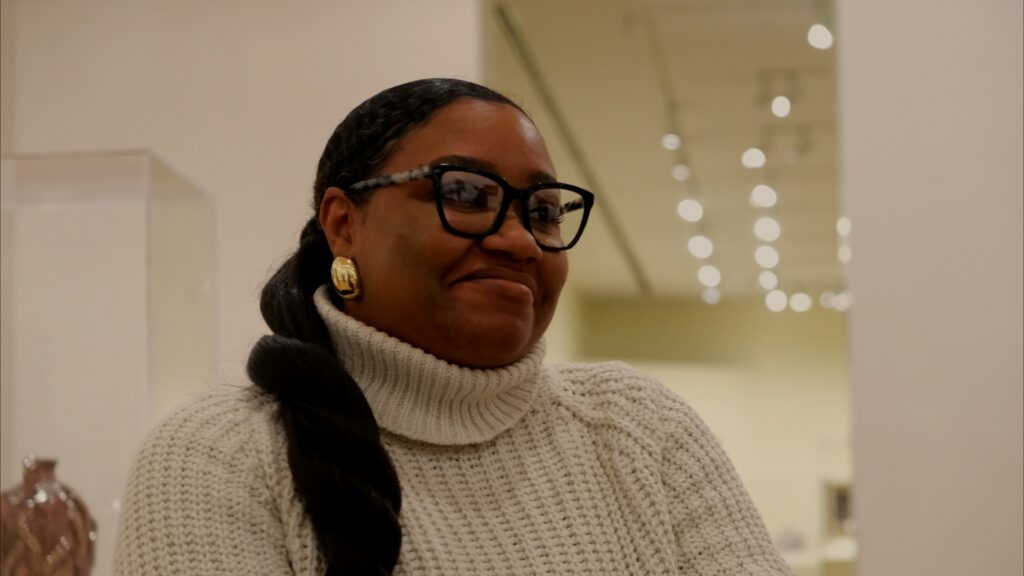 That’s exactly what it is. I love that underlying all of your stories, there’s this emphasis on the role of community and a feeling of confidence being instilled in you. Even if they didn’t have the capacity to teach you much about it, giving you that confidence and the tools to be able to further your craft is so important.
That’s exactly what it is. I love that underlying all of your stories, there’s this emphasis on the role of community and a feeling of confidence being instilled in you. Even if they didn’t have the capacity to teach you much about it, giving you that confidence and the tools to be able to further your craft is so important.
I also think it speaks to the reality that for a lot of Black artists, the path through which you come into your craft might look a little different. It can be an insecurity because sometimes our entry point is from a different place, but I think there’s beauty in that.
Arty: It’s interesting that you say that, because a lot of the artists that we’ve interacted with all have different levels and barriers, as well as being in different places in where they’re taking their art. Whether they’re taking it seriously, or still trying to find themselves as an artist, I think that was the beauty of what Cultural Collateral was about.
We had students, we had people making wonderful art but who really didn’t consider themselves artists, we had people that had never shown their work before, we had people who didn’t even know this could be another way to fund yourself and keep doing things like this. We had a photographer, who showed their pieces, and they were very impactful. Just having that mix of the more seasoned professional or semi-professional artists, and them mingling with folks who were still trying to figure it out was special.
I think it was the day before or day of when we realized the gravity of what we were doing. It was a moment that we all had. During that time, we were all there upstairs getting everything ready, seeing all of the pieces everybody was bringing. And it was just such an overwhelming feeling of like, you have this goal, and then you see everything come together, and you start understanding what the impact is going to be and that people are actually going to come see it.
There was no accident that I reached out to Eb, no accident that Erika and Jamelia painted that photograph, no accident that we all came to this point, where we can really put a mark in history and be a spark, to where we’re bigger than just that room. Black art is bigger than just a room. Our art is part of American culture. It’s a tradition. It shouldn’t just be confined to a couple of walls.
Ebone’: It’s woven into the fabric of the world. I always like to say I’m a Black artist first, an advocate for Black art second, and I’m a Black woman who’s an artist third. That really propels my intentionality. Even with us working in a capacity where my choice and style of art is not amplified or existing, I don’t feel any type of way because very early on we had already, in a very visceral way, acknowledged that it’s bigger than us individually.
Erika: And to bring it to the modern day, we see a lot of how we’re being erased. Our history from textbooks that they’re trying to rewrite, the attempts to whitewash that have been done for a long time. Writing bills to take things out of history, and that’s a disservice to this generation and those coming. It’s hard to know who you are and where you’re going if you don’t even know where you’ve been.
 So historically art also been an avenue for telling stories and reflecting the times and what was happening. I think of Nina Simone’s quote, “An artist’s duty is to reflect the times.”
So historically art also been an avenue for telling stories and reflecting the times and what was happening. I think of Nina Simone’s quote, “An artist’s duty is to reflect the times.”
We by presenting this collective and creating a space for our stories to be told can help with that. Right now, the kids are in a position to believe things that are just not true. We have artists out there, for whom yes art can be creative and just show interpretations of things, but some artists take that duty very seriously, saying, I want to reflect what’s happening and I’ve got to make it in this image because it’s the only way to do it. You can’t even go to a library in certain places to learn it. We need collectives like this, groups who are making a serious effort to say, specifically: “We want Black artists and their stories.” A lot of people say why Black specifically? Because. We love Black artists, and we need our voices heard.
I really recognize a lot of what y’all are doing and saying as within a long tradition of Black artists using whatever gifts and talents they have to storytell, to keep record of history, to communicate what we might not have the time or the tools to express. I think it’s wonderful to be able to have your own practice and way that you use art for yourself in your personal journey, but I love your recognition that you all are a part of something much bigger.
Do you have a favorite medium? If so, why?
Erika: Oil is, I say my favorite, but it’s all I know. It’s how I was taught. But I will say I’m really becoming a fan of this resin medium and incorporating that into the oil paint or to acrylic paint. Resin is something I’m new to, but I like it.
Arty: I’m so happy you asked that question because I’ve been actively having to deconstruct how I’ve learned about art to make myself better. I’ve looked back at some of the stuff I’ve done, and I really enjoy using acrylic but markers, and inking, and bold, thick lines. I’m a huge fan of art from the Congo. They use a lot of pattern work, and a lot of times from a distance things look perfect, but when you get close up, you can see some of the imperfections in the person’s hand. So big, bold, acrylic type of work—I think it lends to the style I like leaning into the most which is illustration.
When I was learning how to make art, not taking away from painting or the other fine arts, but that just wasn’t me. I felt like I was maybe forcing it, but it’s not my medium. I like trying to express myself and my imagination through illustration, I like the cartoony-ness of things, I like the exaggeration of eyes and features, but I also like the styles of our heritage. So a lot of different African tribes, they used a lot of inks on their pottery, in their paintings, in patterns sometimes that meant something and sometimes that just looked good.
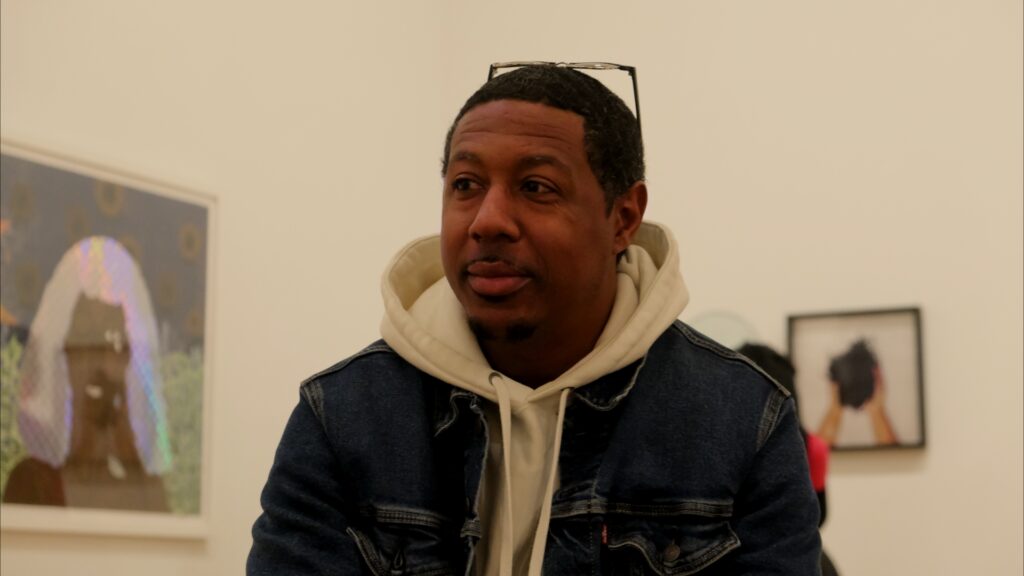 But yes, for me it’s acrylic markers. The thicker the lines and all the linework, I really love that.
But yes, for me it’s acrylic markers. The thicker the lines and all the linework, I really love that.
Jamelia: For me personally, I’ll try anything, but I’m leaning towards acrylics simply because they dry quickly, and that gives you an opportunity to put something down, and if you don’t like it, you can go right back over it and fix it. I think the ability to mix colors with acrylics works a bit better for me, as opposed to oils. Don’t get me wrong, I love painting with oil as well, it just takes too long to dry. So if I had to name one I’d probably say acrylic paint.
Ebone’: I’m gonna be the wildcard. I really appreciate graffiti art. It’s the rebellion behind it. I love the tagging. How are they creating this from a spray can, is where my mind goes. That’s always a wow factor for me. I appreciate watercolor. I appreciate tapestry. Both of my grandmothers were quiltmakers, and so tapestry is woven into my life as well.
Who have been some of your biggest inspirations or influences, in your practice or in your work in general?
Ebone’: Nina Simone, Eartha Kitt, Grace Jones, Josephine Baker. I could go on, but I’ll stop there.
Erika: Nina Simone, I love the personality and the drive behind who she was as a musician, the boldness. Kerry James Marshall is one, for his style. Carrie Mae Weems, for her very candid photos of everyday life in the Black household. It was something about how she captured those moments to where it resonated. I’ve always been a fan of hers as a photographer.
Arty: Starting with some living artists, I love Paper Frank’s stuff, I see it as an illustrative take on Black culture which I really appreciate, and it inspires me. Loveless Melvin, he’s a tattoo artist from Atlanta, and also has a comic book out. I also like Keith Haring, I like his linework. Some more popular artists like Kaws, and Takashi Murakami. I really like his far out-ness, and how he mixes the traditional aspects of his culture in with the modern. I feel like that’s where I kind of fall in. With Keith Haring, I like a lot of his stuff from the ‘80s when he was using his art to create a message about what was going on around him at that time. That whole class of artists.
Jamelia: I’m not answering this question. (laughs) That’s the hardest question I’ve been asked this year. There are too many people to boil it down to just a few, but next time I got you.
Arty: I would say these young ladies as well, Ebone’, Erika, and Jamelia, have definitely inspired me with their work and dedication. We had a meeting one time, and Ebone’ is very committed and passionate about the work she does. You’ve got to have someone in the group that kind of sparks that flame. She was doing that.
When you’re working within a group, people can inspire you in different ways. You could take that in any way you want—as they don’t know what they’re talking about and get upset about it, or as, let me see how I can get better at this thing. I think I definitely look at them as inspiration when it comes to drive. Even with that first art show, when we were having our first calls.
 I do think there’s something very powerful about forming a small group made up of folks you trust and look up to, whose perspective and feedback you value, and who you can learn from and feed from to grow.
I do think there’s something very powerful about forming a small group made up of folks you trust and look up to, whose perspective and feedback you value, and who you can learn from and feed from to grow.
Arty: It feels like you’re doing it for more than just yourself.
If there’s anything you’d like to add, what has the role of community, history, and heritage played in your journey as individual artists and within the collective?
Ebone’: Historically, we have been a niche of people, who are rebels with cause, who have been able to use adversity, anger, being impassioned to invoke revolts. In my personal work, I teach aerial pole dance in the Bible Belt in Alabama, in a space where it is one of the most stigmatized and stereotyped styles of dance that you could do. The fact that I have a background in theater and dance, I’m able to transform the negative connotation around this particular art form and add a great level of culture to it.
We look at this particular thing as an apparatus only, what we’re able to do, how we’re able to contort our bodies, extensions. I still teach ballet terminology even though we’re in this particular style, and I believe that I’m planting the seeds in all of our students for them to have their own personal revolt. We’re raging against a very interesting machine in my capacity, and to go from dancer to instructor to where I am now, I hope the trajectory is similar for a lot of the other ladies that are in this art form. Every time we decide that we’re going to touch this pole, we are raging against a machine.
I believe so. You’re in a sense alchemizing negative stereotypes that are really not for us to hold. It takes a high level of skill and artistry to pole dance, but it’s very much looked down upon, especially when the dancers are Black women.
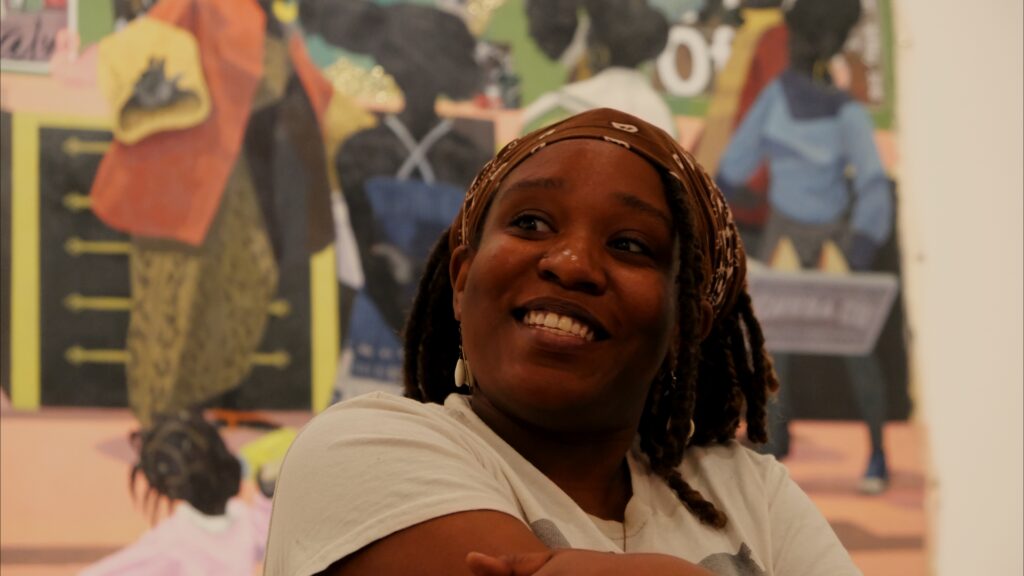 Erika: I’ll expand on what I was saying earlier, kind of in the vein of Ebone’’s personal work in dance and theater like the Josephine Bakers of our past. I feel like as talented as she was, she was definitely suppressed and oppressed in her artistry, but she still saw value in herself to say, “No, you won’t silence me. I’m gonna show this.” She was very gifted and talented and captivating to the world, but she was Black and still had to deal with that side of how society viewed her.
Erika: I’ll expand on what I was saying earlier, kind of in the vein of Ebone’’s personal work in dance and theater like the Josephine Bakers of our past. I feel like as talented as she was, she was definitely suppressed and oppressed in her artistry, but she still saw value in herself to say, “No, you won’t silence me. I’m gonna show this.” She was very gifted and talented and captivating to the world, but she was Black and still had to deal with that side of how society viewed her.
Being an African-American, a Black person, there has been no other culture in the world who has dealt with the suppression and oppression that we have. Yet by the same token, we have still found ways to express ourselves through pain, in a positive way. We still find ways to innovate. We still find ways because we have always had to find a way.
We’ve been looked at as not even human at times, and we still find ways to laugh. We have comedians who have told amazing jokes and found ways to laugh through pain. We have the theater, that has given stories of our pain but still found pockets of joy and love. Being that we’re so unique in our experience, not just in America but all over the world, we need art to continue those safe spaces for that kind of expression. Like I mentioned before, with states trying to wipe away the history that really existed, these types of groups, collectives, organizations, have to continue to pop up and thrive so that we can continue to tell our stories through all of the different ways they try to control and oppress.
Arty: We’re continuously amplifying and echoing that message of storytelling, through the visual arts, through the performing arts, through music, and that’s something that’s been happening since we were brought here, even before then. Art for Black people is not just a means of expression, but a means of communication, documentation, spirituality, for coming together and educating on what came before us.
As we even stand in this room, each one of these pieces is not just expression. It’s telling a story, it’s capturing a history. There’s something to learn within all pieces of art. When you look at American culture, and Black people and how we contributed to it, at every stage of different industrial revolutions, there was a way that Black people captured and expressed what they were going through.
What we were going through at those times wasn’t necessarily even looked at or thought about. If it wasn’t for Langston Hughes, and so many other musicians, artists, and writers, there might not have been any way for us to know what was going on at that time. For Dr. Martin Luther King Jr. to even gather the momentum that he did during the Civil Rights Movement, there were a lot of Black artists who were instrumental. Without those people and them capturing that moment, we wouldn’t have so many timeless art pieces, pieces of music, forms of dance. It was rooted in something.
 Going back to Roots and Renaissance, that’s really what it’s all about. It’s about going back to our actual history and heritage, and bringing that through to create another renaissance, again. There are pockets of the Black renaissance happening everywhere, and here in Fairfield and in Birmingham, we’re just echoing what we were taught as kids. We feel responsible for creating another root for generations to come after we pass. All the art that we’re creating right now, somebody’s gonna see it, somebody’s gonna remember it, and then they’ll be inspired too. Us doing this, we’re in history.
Going back to Roots and Renaissance, that’s really what it’s all about. It’s about going back to our actual history and heritage, and bringing that through to create another renaissance, again. There are pockets of the Black renaissance happening everywhere, and here in Fairfield and in Birmingham, we’re just echoing what we were taught as kids. We feel responsible for creating another root for generations to come after we pass. All the art that we’re creating right now, somebody’s gonna see it, somebody’s gonna remember it, and then they’ll be inspired too. Us doing this, we’re in history.
When they look back at history and what we’re doing right now, we’re cemented in history. Someone will read this article and look at these pictures, and they’ll be like, “Yeah, I read about this art collective, that’s doing something exactly like what we’re trying to do again right now.”
Jamelia: These people are amazing. (laughs) Seriously. There isn’t anything else that I can say that they haven’t already. Every point I was going to make has already been made.
As a group, what has been your most exciting event or program to date?
Ebone’: The art supply drive stands out to me primarily because there are no art programs in the Fairfield City school system, and we had a conversation around it being one thing if we can’t facilitate it because we don’t have the supplies or the means; but when you do have the supplies or the means, is it still an issue?
One thing I like about FBAC is that we literally seek and look for voids to fill, and that’s a driving force for us. Just contacting schools and them being overjoyed with the fact that somebody wanted to give them art supplies, and they didn’t have to do anything. We said no, just identify the teachers and the program, and we will deliver. Being an organization that’s really adamant and hellbent on our deliverables—that’s a reward in and of itself.
Because we always said we were going to take care of home first, and we’re doing just that. I always say little by little, a little becomes a lot. The art supply drive, for sure.
Erika: And we’re so new. We just started in January and formally organized in July. In that short amount of time, we gained enough support from our community, the art community within the Greater Birmingham area to trust us enough to deliver and enough to support us.
Our first donation was $1,000 to the marching band at Fairfield High Preparatory School. In the art supply drive, we were able to donate almost 500 items, 474 to be exact. We donated art bins to three classrooms within Fairfield City Schools, Robinson Elementary, Glen Oaks, and Mt. Pilgrim Christian Academy, one having an art teacher Eboni, who was very appreciative and gave us feedback as to how hard it is to provide art supplies in classrooms.
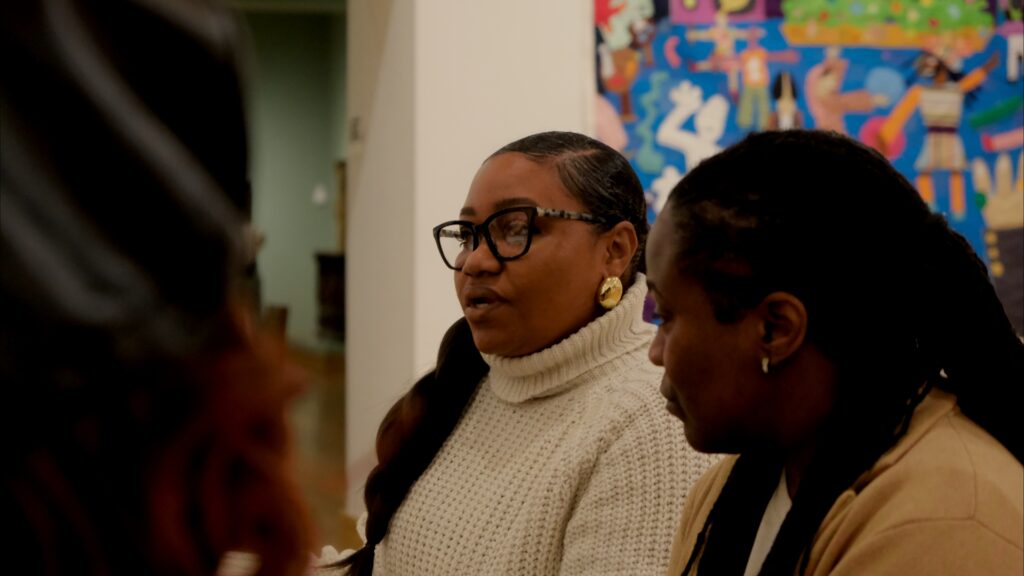 So we’re grateful for after this short amount of time to show how we’ve been able to connect with our community, by how we’re interacting with them, making our voices heard, and just making sure people feel valued, seen, and heard. When you do that, that’s what helps a person say, “Let me see what you’re about.”
So we’re grateful for after this short amount of time to show how we’ve been able to connect with our community, by how we’re interacting with them, making our voices heard, and just making sure people feel valued, seen, and heard. When you do that, that’s what helps a person say, “Let me see what you’re about.”
Personally, for my favorite event, I love the impact we made with the schools and the supply drive. But I think for me it’s going to be our show Cultural Collateral, only because the feedback we got from guests that attended, including the artists and vendors, there was a common tone of “This is so different. This doesn’t get to happen often in Birmingham.”
It gave us something different to do, it was sophisticated, it was interesting. Maybe you’re not a collector or never thought about buying art, but now that’s something you might be interested in. Even if you just came by way of somebody invited me because they’re doing something at the event, it was the feeling and the atmosphere that we provided. You felt like you walked into a museum, but you only saw yourself. I guess maybe it was the way we produced the show, the entertainment we had, but the way it was presented on the walls, it just made people feel like they were somewhere else.
Ebone’: People told me, “Eb, this does not feel like Birmingham.” But then somebody said, “Well, this is the new Birmingham.”
Erika: Yes, that was nice to hear, nice feedback. And there were close to 200 attendees.
Ebone’: We lowballed. We thought, 50-75 people and we’ll be okay.
Arty: For me, I don’t know if it’s any one event. I’ve really enjoyed the journey of how we are growing and learning. I have a mentor who’s been teaching me that the end goal is going to come—the only thing standing between you and that is time, and for me, I’ve been learning to focus more on the process. The meetings, the staying up, being late with things, getting angry, the work that has to be done for this end goal to happen. The process for me what was I enjoyed the most.
The day before the show. My parents always talked a lot about how the day before the show is always when the most fun and excitement happens. When we were actually there and figuring out how to put the pieces up, seeing all the artists show up with their work, and all the conversations we got to have them, that was my favorite part. I remember we had this zoom with all of the artists for Cultural Collateral, and hearing all of their origin stories and understanding the heaviness of what we’re doing.
 Every step of the process was exhilarating for me. I wouldn’t change a thing, I don’t regret anything, because I know when it’s something this important, there are a lot of steps between taking something from this idea to something bigger. It was our first time doing that, and that was some hard work. We were frontline talking to people, getting things situated and setting up. All of it was worth it. I would do it again ten more times.
Every step of the process was exhilarating for me. I wouldn’t change a thing, I don’t regret anything, because I know when it’s something this important, there are a lot of steps between taking something from this idea to something bigger. It was our first time doing that, and that was some hard work. We were frontline talking to people, getting things situated and setting up. All of it was worth it. I would do it again ten more times.
Erika: One more thing, it was also exciting for me in the sense of the sales we were able to make at that show. It’s not about the money, but as Arty mentioned, there was no Black art collective in Birmingham. As a visual artist that was moving in the art community, I had experience from the artist’s side, and I saw a need.
There are artists’ guilds and artist incorporated collectives that exist, but none that necessarily focus on Black art. There are definitely Black artists that are a part of them, but certain types of art are more welcomed than others in my opinion. The things that are really in your face, like some of the pieces in this room, that didn’t feel like the first thing that people were gravitating towards in what existed. By us creating this collective, we wanted to welcome the bold, and our stories in whatever way that they’re expressed. We had that all around the room.
And to also gain the trust and the buy-in of your fellow artists, those who look like you, that meant so much because it’s difficult. These are artists that have already been working shows in different parts of Alabama, and traveling outside of Alabama because it’s been hard for them to get their work bought and sold here unless they have a private collector who’s invested in them. So being this new collective that they’ve never heard of, and to get their buy-in when we’re saying, “Please trust us to show your work, and we’re going to try to get it sold also,” was amazing.
We’re gonna give you a good time, but we really wanted to curate an audience that was also there to purchase art, who appreciate art and know the value. We were very strategic about our marketing and the conversations we were having within the art community, with suppliers, and collectors. By doing that with that show, we were able to collectively sell close to $2,000 worth of work. For a first show. We don’t want to put it at the forefront, but artists deserve to feel valued. We want to support living artists. We want them to be able to pay their bills with their gifts. We don’t want to be appreciated once we die.
What is your greater vision for your community and the artists coming behind you?
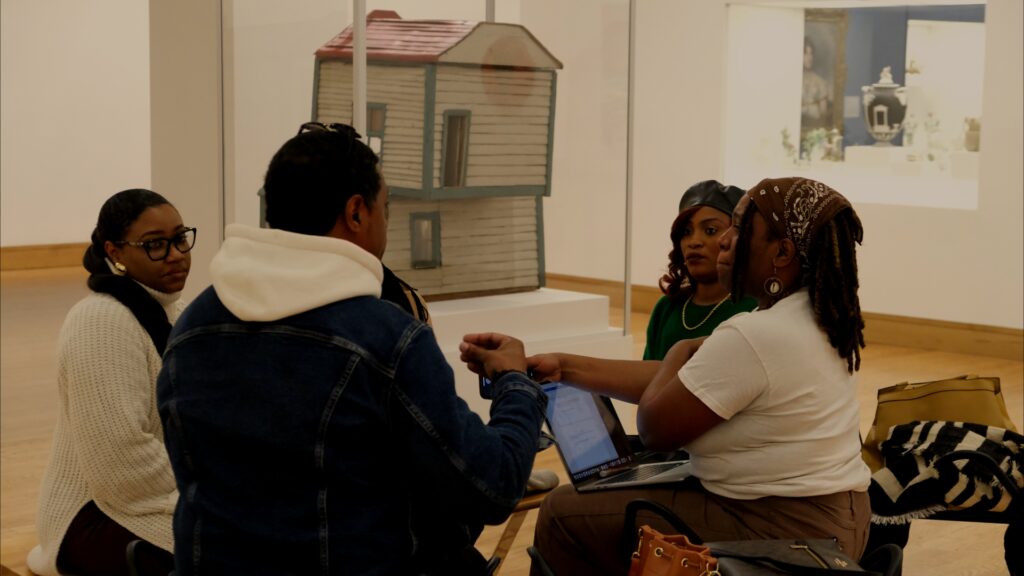 Jamelia: For me, like Erika touched on earlier, you have to know where you come from to know where you’re going. As far as what I see in Fairfield today, I think that a lot of people don’t understand or appreciate what our people have gone through in our small little community.
Jamelia: For me, like Erika touched on earlier, you have to know where you come from to know where you’re going. As far as what I see in Fairfield today, I think that a lot of people don’t understand or appreciate what our people have gone through in our small little community.
We walked in today and found we probably know all of your people, and you probably know some of ours. That sense of community and staying together, being together, and knowing that if we’re all on the same accord, we can accomplish anything. We can do whatever it is that we want to do if we put our minds, our talents, our drive to work. I would like to see that sense of community come back, that togetherness.
Arty: I don’t have anything to add. We all remember Fairfield as a deep community, and that’s what I would like to see that come back.
Ebone’: I like the quote from Issa Rae, which I think will become an adage for your generation and those after you, where she talks about how she’s reaching across the table toward tangible people around you and in your community, rather than going up which to me means that we’re outsourcing it to someone else. When we reached across this proverbial table, we had no idea how much each individual had in their wheelhouse. We went in with a great level of hope and optimism, but we each also had a level of intention. I hope to see more of that for us.
You can’t trust everybody, but I would much rather trust somebody I have a level of commonality with, who can understand your background. I like the idea that we’re a group that if we don’t know how to do it, we know someone who can, someone who has the experience and is equipped to be efficient and effective.
Any programming or anything else exciting coming up that you want to let the people know about?
Arty: We have a lot of exciting ideas and possible collaboration opportunities down the line. In the meantime, you can visit our website at www.fairfieldblackartcollective.com to see what’s next and to see what we’ve worked on so far.
Erika: Upcoming, there will be Roots and Renaissance, running from February 11th-May 10th, and it will be installed at Miles College. This is a show that we curated partnering with Miles, and it will be a group of artists from Fairfield, Birmingham, and surrounding areas that will be showing their work in the C.A. Kirkendoll Learning Resources Center. Anyone in the community interested in seeing Black art can come out and view that work any time during the hours that the LRC is open, Monday through Thursday, 8:00 am – 10:00 pm, Friday, 8:00 am – 5:00 pm, Saturday, 8:00 am – 3:00 pm, and Sunday 2:00 – 6:00 pm. Art will also be available for purchase.
Arty: If you can’t make it to the physical gallery for Roots and Renaissance, we’ll also have a virtual art gallery on our website at www.fairfieldblackartcollective.com where the art will be available to view, you can learn about the art and the artists, as well as purchase if you’re interested.
Members Info:
Erika Mixon, Co-founder & Executive Director
Ebone’ Gilbert, Co-founder & Co-Executive Director
Atuarra McCaslin, Co-founder & Marketing Director
Jamelia Pearson, Co-founder & Director of Finance
Social: Instagram / Facebook @fairfieldblackartcollective
